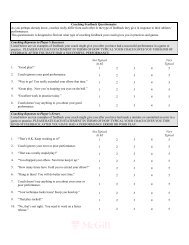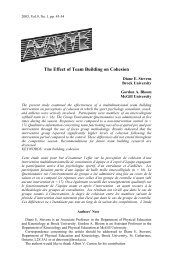International Journal of Sport Psychology
International Journal of Sport Psychology
International Journal of Sport Psychology
Create successful ePaper yourself
Turn your PDF publications into a flip-book with our unique Google optimized e-Paper software.
(Cecil & Stanley, 1997; Crocker, Snyder, Kowalski, & Hoar, 2000; Eklund &<br />
Bianco, 2000).<br />
Body issues are especially salient when adolescents are concerned that<br />
their body might not meet others’ expectations (Leary & Kowalski,<br />
1995).When adolescents are unsure whether their desired impressions can<br />
be achieved in settings where social evaluation is salient, they can experience<br />
social anxiety. Social physique anxiety (SPA) is a specific type <strong>of</strong> social anxiety<br />
where the anxiety experienced by an individual is in response to perceptions<br />
<strong>of</strong> others' evaluation <strong>of</strong> his/her physique (Hart, Leary, & Rejeski, 1989).<br />
SPA was originally conceptualized as a trait characteristic (Hart et al., 1989),<br />
and it is correlated with physical factors such as body fat, weight, and height<br />
(Cox, Lantz, & Mayhew, 1997; Crocker et al., 2000; Hart et al., 1989). But<br />
SPA is increasingly being examined at the state level (e.g., Kowalski Mack,<br />
Crocker, Niefer, & Fleming, 2006; Mack, Strong, Kowalski, & Crocker,<br />
2007), suggesting it may also be conceptualized as an emotional state. Furthermore,<br />
trait and state SPA have been found to be moderately correlated (r<br />
= .44; Kowalski et al., 2006) in a sample <strong>of</strong> adolescents, suggesting that they<br />
are distinct, but related constructs.<br />
The sport environment is a public context that has an inherent focus on<br />
physicality, and therefore is an important domain in which to study SPA.<br />
Simply stated, sport places the physical body on center stage (Greenleaf,<br />
2002), and <strong>of</strong>ten leads to the body being objectified as an instrument <strong>of</strong> performance<br />
and physical attractiveness (Cox & Thompson, 2000). Furthermore,<br />
female athletes have to negotiate the discourse surrounding gender<br />
and heterosexuality that <strong>of</strong>ten clash in sport as a result <strong>of</strong> a desire to be seen<br />
both as physically strong and feminine (Cox & Thompson, 2000). Training<br />
<strong>of</strong>ten leads to a more muscular physique that is necessary for high performance,<br />
but it can draw the body further away from feminine ideals and<br />
increase concerns <strong>of</strong> being viewed as masculine or abnormally strong<br />
(Mosewich, Vangool, Kowalski, & McHugh, 2009). This conflict may resonate<br />
both inside and outside the sport context.<br />
Within sport, individuals may pursue activities that will take them closer<br />
to their ideals, even if it will harm their athletic performance (e.g., restrictive<br />
eating behavior, overtraining, skipping strength programs). Outside <strong>of</strong> the<br />
sport context, this conflict may arise in situations where the inability to meet<br />
the cultural ideal is amplified (e.g., an athlete may become distressed when<br />
trying on clothes if she finds that most are not designed to fit her muscular<br />
body). This conflict, and experiences <strong>of</strong> SPA in general, are not confined to<br />
particular types <strong>of</strong> sports such as aesthetically judged sports (e.g., gymnastics)<br />
or sports in which more revealing attire is worn (e.g., swimming). SPA<br />
370




